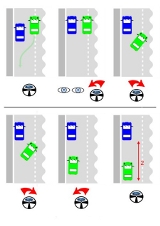Click here for a printer friendly version.(Opens in a new window).
When practicing the reversing manoeuvres pupils always ask me for a reminder on the reference points and a recap on how we carry out the manoeuvres. With this in mind I thought it would be a good idea to make a quick guide.
When reversing there are a few points to remember
- When you turn the steering wheel to the left or towards the kerb the rear of the car will move closer to the kerb.
- When you turn the steering wheel to the right or away from the kerb the rear of the car will move away from the kerb.
- If you turn the steering wheel left the front of the car will move to the right.
- If you turn the steering wheel right the front of the car will move to the left.
- For example the rear of the car goes which way you turn the wheel and the front of the car turns opposite.
- Turn the steering wheel in small amounts and give the rear of the car time to react.
Turn in the road
To begin this manoeuvre, stop the car about 6 inches away from the kerb, (too far away and this exercise is made more difficult than it needs to be). Carry out all round observations, then move the car forwards very slowly using bite and dip, and at the same time turn the steering wheel quickly to the right.
When you reach 1 metre from the kerb, pause, (the reference point we can use is when the kerb is visible under the right hand side mirror), we then start to move forwards and turn the steering wheel to the left as far as you can before reaching the kerb, then stop.

Again start all round observations, finishing over you left shoulder, then start reversing, turning the steering wheel all the way to the left.
When you reach halfway across the road, pause and have a look left and right, then look over you right shoulder and look at the position of the kerb,(still turning left). When you reach 1 metre from the kerb, (when the kerb lines up with a mark about 1 inch above the door trim) pause, then when you start moving turn the steering wheel to the right and stop before you reach the kerb.
All round observations then move forwards, turning the steering wheel to the right.
Left Reverse
To start this manoeuvre stop the car about 8 to 10 inches away from the kerb and about 2 car lengths away from the corner.
Carry out all round observations, finishing over your left shoulder,then start to reverse, all the time looking out of the rear window. Stop the car when the kerb closest to you disappears from view out of the rear window. At this point check the left mirror and make sure that the rear of the car is level with the start of the corner.

All round observations then if safe!! Start reversing and straight away turn the steering wheel 1/2 turn to the left. Stop after moving about 1/2 car length and check the mirror to see how close to the kerb you are. Start moving again and stop after another 1/2 car length and check the left mirror. Keep moving and stopping after 1/2 car lengths until you are facing the road opposite and the kerb looks parrel to the car,(by using the mirror and view out of the rear window).
If you stop and realise the kerb is a long way away then turn the steering wheel toward the kerb,(do not oversteer!!). If the kerb is close then turn the steering wheel away from the kerb. See the notes at the beginning of the page.
Straighten the steering wheel and follow the kerb backwards for a reasonable distance.
Reverse Around a Parked Car.
Stop the car reasonably close the parked vehicle and so that the rear of your car is about halfway along the parked vehicle, (we stop reasonably close to the parked vehicle so that other vehicles can pass us on the right! If possible.)
All round observations and start reversing, looking out of the rear window, and stop when the rear of our car lines up with the rear of the parked vehicle. Check forwards and backwards and if safe start reversing and turn the steering wheel 1 turn to the left. Stop when the car faces 2 o'clock of just before.

Look around the car then start reversing and straight away turn the steering wheel 1 turn to the right and continue back until our left mirror lines up with the mirror on the parked car, then stop.
Look around the car again and check the left mirror, (this position is very important to us, because if we get to close to the kerb then your job will be very difficult). When happy with our position, start moving backwards and turn the steering wheel 1 turn to the right. Keep stopping and checking the left mirror because this is our crucial phase, so we don't hit the kerb.
When we are happy with our position in relation to the kerb and just before we are parrell to the kerb, turn the steering wheel 1 turn to the left, so that the wheels are pointing straight ahead. Stop the car when happy.
A couple of points to remember with this manoeuvre. If you move past the 2 o'clock position then the rear of the car will be closer to the kerb, so you might have to apply full lock to the right instead of 1 turn and you might have to start turning before the mirrors line up!! (So stop before you reach 2 o'clock, and think about your position).
Bay Parking.
There are a couple of different techniques to carrying out this manouevre, Drive straight forwards and reverse a right angle either to the left of right, of drive into a bay opposite the one you want then reverse in a straight line backwards.
We can start with the first option of driving straight forwards and reverse a right angle either to the left of right.

Drive straight forwards and stop about 3 or 4 bays past the one you want to reverse into, and stop. All round observations are essential here. Reverse in a straight line until a line of a bay is about half way along the front door and stop. All round observations again, then start to reverse and turn the steering wheel briskly to either the left or right, (depending on which way you want to reverse to). Keep pausing and looking around the car and take time to look into the mirrors. When the rear of the car is in the bay and you look level with the bay opposite then straighten the wheel and the front wheels, and continue reversing until you are in the bay.
The bay line you position half way along the front door depends on which bay you require to reverse into. Once you have decided which bay to want to end up in, count 2 bays along and use the line furthest away. Check the diagram to help you in this manoeuvre.
The other, easier option for bay parking is to drive forwards into the bay opposite, (try to get into this bay as straight as possible and get the front wheels straight). All round observations, then check the mirrors and reverse slowly into the bay behind you, keep stopping and check all round and look in the mirrors.
Click here for a printer friendly version.(Opens in a new window).
